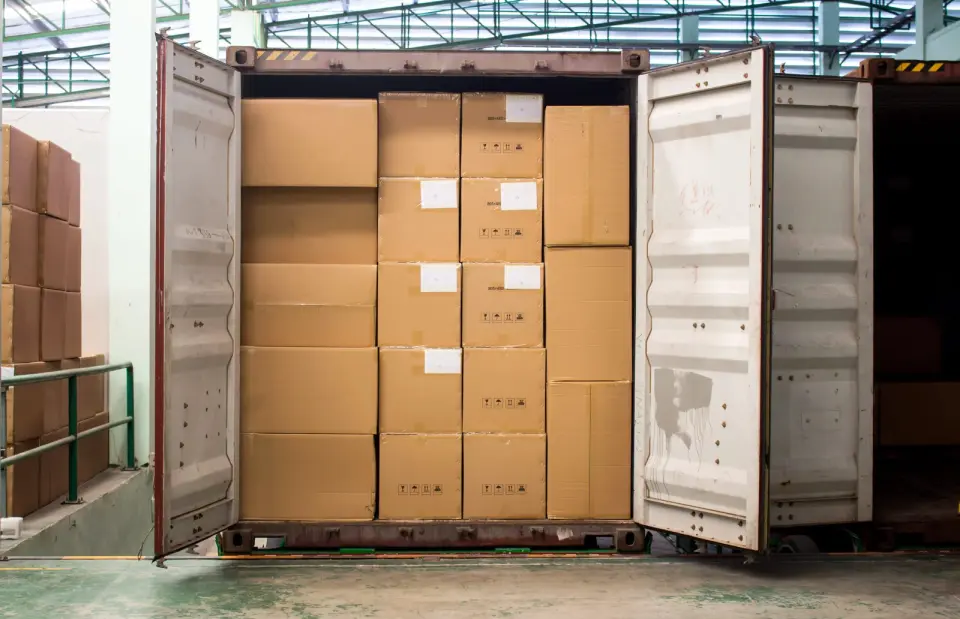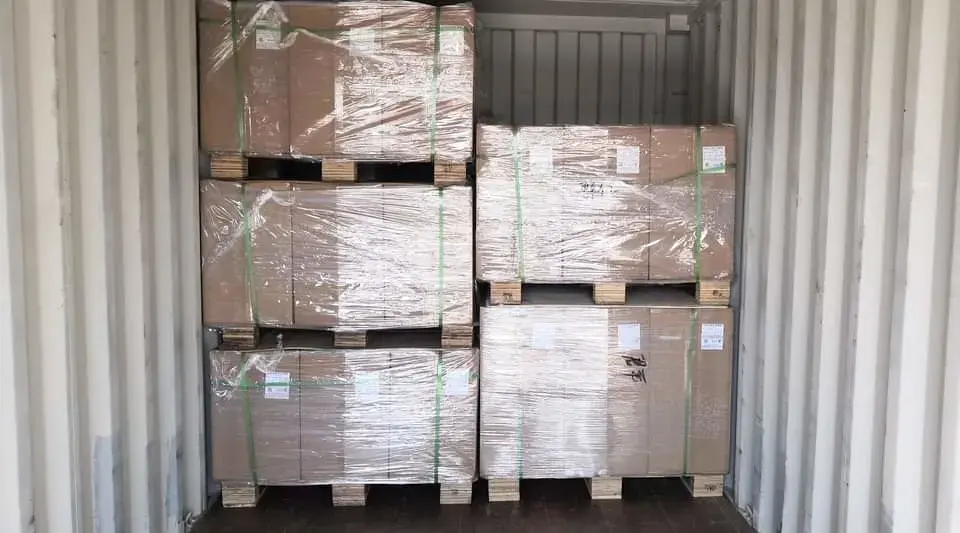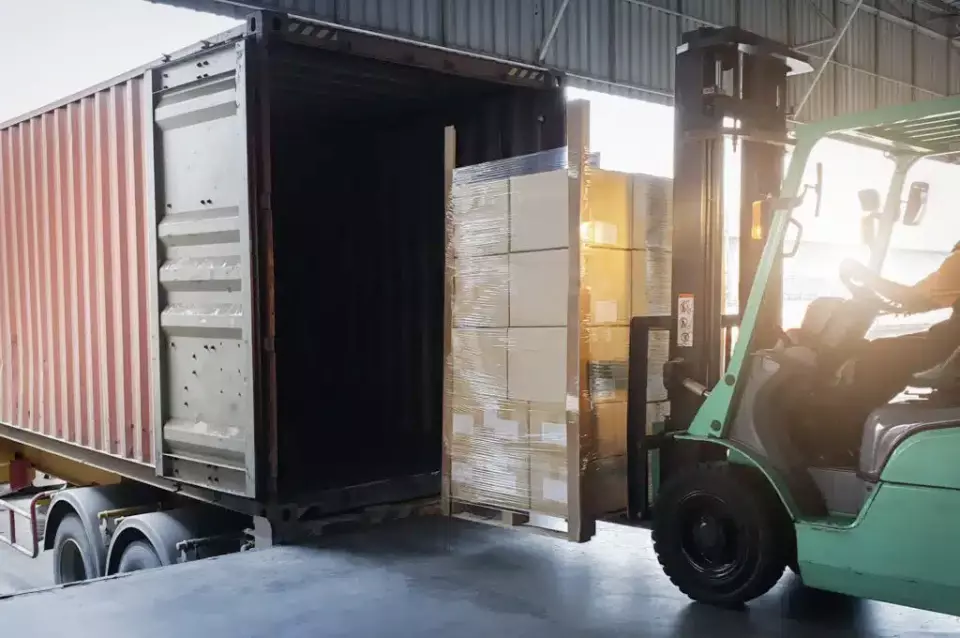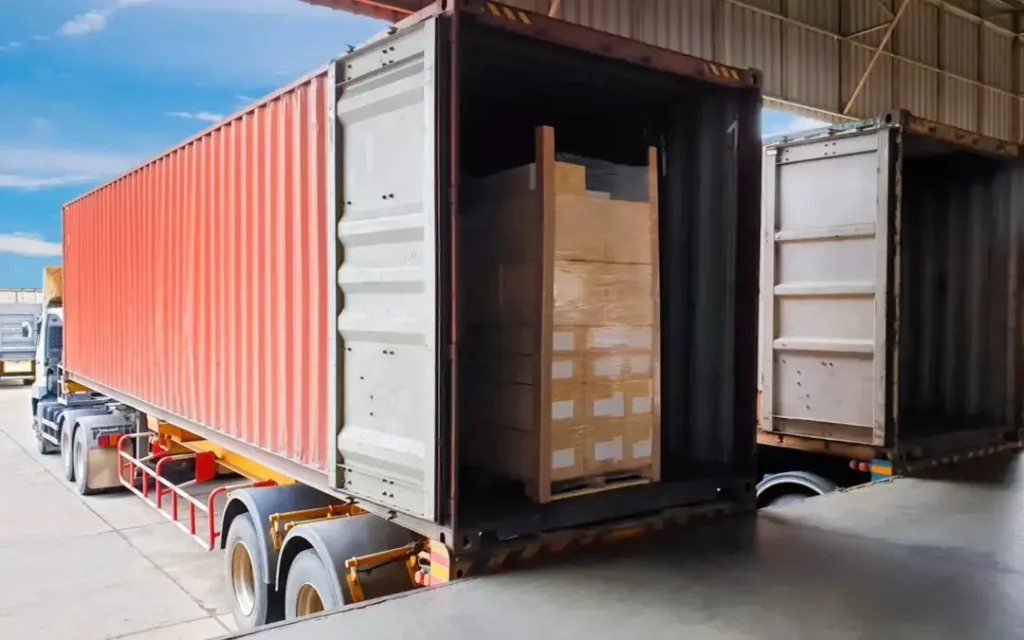A 2018 Flexport study showed that only 64.6% of FCL containers were utilized to their full capacity. Today, container underutilization is one of the biggest loss drivers, costing shippers millions of dollars due to inflated freight spend.
As a result, there’s a growing need for solutions and methods to minimize inefficient cargo space utilization and optimize cargo loading processes for improved revenue and cost reduction.
In today’s market, there are two main methods of loading standardized cargo to maximize container utilization: floor loading and palletized loading. While floor loading involves stacking boxes directly into a container without any pallets or other support structures, palletized loading involves placing goods onto pallets first before they are loaded into shipping containers.
Both methods offer various benefits and have their drawbacks which we’ll discuss in this article. It’s important to mention that there is no single best container loading method. Shippers, forwarders, and carriers choose the most suitable loading method according to the type of cargo, operational setup, customer requirements, and internal preferences.
What Are Floor-Loaded Containers?
Floor-loaded containers are shipping containers in which cargo or goods (often in cartons) are loaded directly into a shipping container. Shippers, forwarders, and carriers who opt for this container loading method do not make use of pallets or other structural supports in order to maximize container space utilization.

Cargo handlers, often called material movers, typically manually stack cartons to create organized cargo layers. This process is also referred to as hand-stacking cartons inside a container and is usually done with a team of handlers.
Before cartons are loaded into the container, they are placed at the staging area that is located at the loading dock. They are then moved into the container using a pallet. Handlers then “break” the pallet, remove individual cartons from it, and start hand-stacking the cartons.
Floor loading is usually the preferred loading method for transporting cargo with standardized packaging, such as cartons or boxes, due to their ability to be easily stacked. This allows shippers to maximize cargo space.
What Are Palletized Containers?
Palletized containers are shipping containers in which cargo is loaded using standardized pallets. Individual goods or cartons can be loaded onto pallets, and they can even be stacked.

Pallets provide a stable and uniform base for securing cargo. In many cases, they can improve space utilization by allowing for better organization and more convenient access.
They can even reduce the risk of damage by shielding items from coming into direct impact with one another using dunnage. However, it’s important to note that using shipping pallets will not achieve the same space efficiency as hand-stacking cartons.
One of the main advantages of loading containers using pallets is that cargo handlers are able to use forklifts, pallet jacks, and other equipment to ease loading and unloading. This not only makes the entire process more convenient but also more efficient.
Comparison Between Floor-Loaded and Palletized Containers
In this section, we will delve into a comprehensive comparison between floor-loaded and palletized container loading. We will highlight the advantages and disadvantages of each method in relation to space utilization, ease and speed of loading and unloading, cost-effectiveness, equipment requirements, and more.
Container Utilization
Container utilization is a common supply chain and shipping key performance indicator (KPI) that is used to measure how optimal a container is loaded. To be more specific, it measures the ratio of used cargo space against the overall inner volume of a shipping container.
With this in mind, floor-loaded shipping containers typically yield higher space utilization which is typically between 85% to 95%, depending on the type of commodity and container. Since the method of loading revolves around stacking each carton on top of each other, the space inside the container is more efficiently occupied.
In contrast, pallets require additional container space and usually have gaps to enable handling through forklifts. This reduces the overall utilization to around 70% to 85%, on average.
Ease of Loading & Unloading
Floor loading is a more labor-intensive process as it requires a team of cargo handlers who have to physically load each carton into shipping containers by hand. Moreover, they have to carefully position each carton or box on top of each other while operating in tight spaces.
Conversely, palletized loading allows handlers to use forklifts, electric pallet jacks, and other type of handling equipment that helps to simplify the loading process and reduce reliance on manual labor.
Loading & Unloading Speed
In light of the loading process that we’ve mentioned earlier, floor loading is more time-consuming than palletized loading as it requires multiple handlers to manually load cargo onto containers.

Depending on the container and cargo size, it can take a few hours to complete the process. On the other hand, palletized loading makes use of forklifts and other material-handling equipment (MHE) that can accelerate the loading and unloading process.
Palletized container loading can be completed within 20 to 45 minutes, depending on the type of commodity, container size, and whether pallets are stacked.
Cost-Effectiveness
As floor-loaded container maximizes space utilization, it allows shippers and carriers to transport more cargo more efficiently. This directly translates into cost savings, as on average fewer containers are needed to move the same number of goods.
While shippers can save on freight costs, the loading and unloading processes require manual labor and additional time. Therefore, they may not always find it profitable to floor-load containers, especially in markets where labor costs exceed the cost of shipping.
Conversely, while palletized loading may achieve higher handling efficiency, especially when transporting smaller cargo that has already been consolidated on pallets, shippers aren’t able to maximize container utilization.
While they are able to save time and resource costs through faster loading speeds, shipping palletized cargo often increases overall freight spend, as on average more containers are needed to ship the same volume.
Ultimately, the most cost-effective method for shippers, freight forwarders, and carriers can be calculated by comparing total freight cost against the labor and equipment cost.
Cargo Safety
Palletized cargo inside a shipping container is less susceptible to damage during handling or transit when they are appropriately secured. Pallets that carry loose cargo or cartons are typically wrapped with linear low-density polyethylene (LLDPE) that holds it well in place during transit.
Pallets also serve as structural support, whereby the wrap, corner boards (sometimes called edge protectors), and dunnage, prevent the cargo from coming into contact with other pallets or the container itself.
On the other hand, floor loading can introduce risks of cargo damage if the container is not fully utilized. In other words, the lower the container utilization, the more vulnerable it is to damage since there is more room for cartons to move and topple during transit.
Cargo Suitability
Cargo with standardized packaging can be either transported using floor or palletized loading methods. Most shippers opt for floor loading when transporting stackable cargo, especially if the packaging is designed to withstand the entire stack’s weight.
Therefore, floor-loading or hand-stacking may not be suitable for heavy cargo, such as perishable or sensitive goods like food, glass products, machinery, equipment, and similar.
Conversely, cargo that does not have uniform packaging and that is either too large or heavy for manual loading is often palletized. This includes heavy consumer goods, electronics, spare parts, pharmaceuticals, and industrial equipment, to name a few.
How to Choose & Implement the Right Method
Choosing between floor loading and palletized loading methods requires proactive planning and strategizing. Both methods offer different benefits and drawbacks, as explained in the previous section.

Below is a guide designed to help shippers, freight forwarders, and carriers decide how to select the most suitable loading method based on their cargo and shipping requirements.
1. Identify Your Cargo Urgency & Specifications
Before deciding on a loading method, it’s crucial to check whether the cargo and its packaging are stackable. Some goods may be stackable but are too fragile to transport without pallets and corner boards.
You should also assess the dimensions and weight of the cargo to determine if they are better suited for floor or palletized loading. The shipping mode is also important to factor in, for example, FCL or LCL.
FCL shipments don’t require handling during transit, so floor loading may be more feasible. On the other hand, palletized loading may be ideal for urgent or LCL shipments as they allow for faster loading and unloading.
2. Understand the Cost Impact
Other important aspects that should be considered are labor and freight costs, as these can help to determine which method is more cost-effective. Underutilized cargo space can increase freight costs significantly.
For instance, if a shipping container is only 50% utilized, the cost of moving freight will be twice the amount it should be, as you’ll need twice the amount of containers to fill the same volume.
However, floor-loading will require manual labor, which needs to be accounted for. This can pose challenges for markets with higher labor costs or in times of labor shortages. Therefore, it’s important to proactively assess the costs of labor versus the cost of freight.
3. Assess Available Resources & Equipment
As mentioned earlier, floor loading requires more manual labor. On the other hand, palletized loading requires the use of material handling equipment such as forklifts and electric pallet jacks.
Both are essential resources that may not always be available on demand. Therefore, choosing between palletized or floor loading could fall to the available resources at the loading and unloading site.
It could also depend on the cost of procuring the required equipment to load and unload cargo. In certain market conditions, labor may be in high demand and cost more than procuring forklifts, and vice versa.
4. Implement Preferred Loading & Unloading Methods
Choosing between palletized and floor-loading can depend on the expertise and experience of your company and its ability to implement these methods. In essence, both of these loading methods require proper training and resources for successful implementation.
For instance, if you opt for floor loading, the ground personnel needs to be trained in different loading techniques, cargo organization, and other essentials. They also need to work in groups, have proper rotation, as well as adequate rest times.
Similarly, palletized loading requires operators who know how to operate forklifts efficiently and safely. Under the bottom line, selecting a suitable loading method requires a careful assessment of equipment, skillsets, and ability to work efficiently.

Get Free Course Access
If you enjoyed the article, don’t miss out on our free supply chain courses that help you stay ahead in your industry.

Gerrit Poel
Co-Founder & Writer
at freightcourse
About the Author
Gerrit is a certified international supply chain management professional with 16 years of industry experience, having worked for one of the largest global freight forwarders.
As the co-founder of freightcourse, he’s committed to his passion for serving as a source of education and information on various supply chain topics.
Follow us